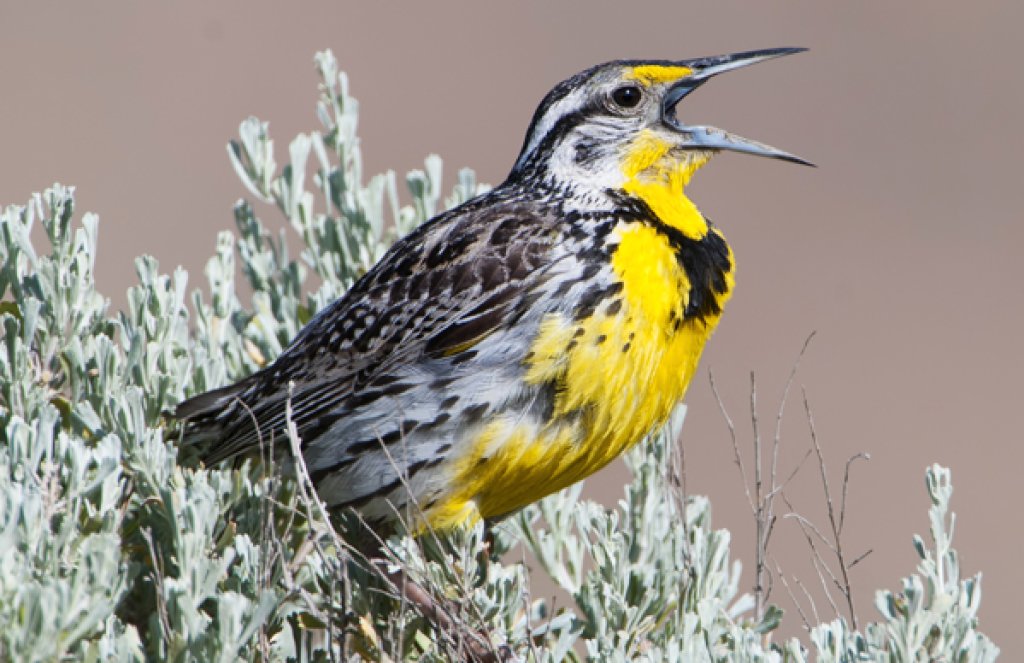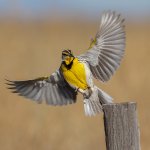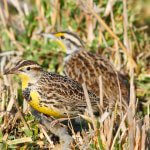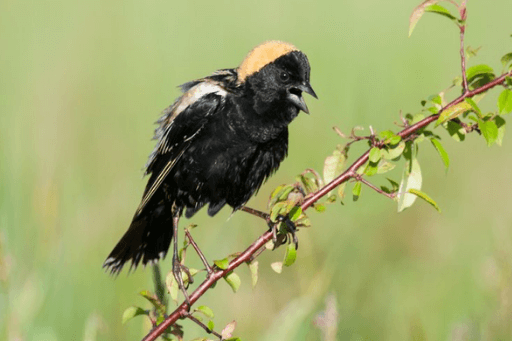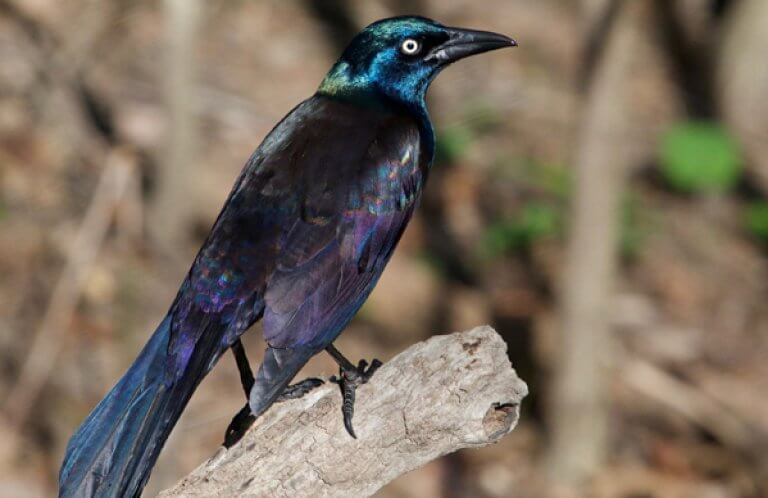About the Western Meadowlark
A common and conspicuous bird across much of North America west of the Mississippi River, the Western Meadowlark was first officially described in 1805 by the famed explorer Meriwether Lewis. However, because this yellow-chested, ground-nesting bird looked so similar to the Eastern Meadowlark, it was not officially recognized as a distinct species until almost 40 years later, when painter and explorer John James Audubon proposed that the Western Meadowlark was a separate species based on its very different vocalizations. Audubon gave the bird its Latin species name neglecta, since it had been overlooked for so long.
A Popular Pick
A colorful bird of wide-open spaces, the Western Meadowlark proved a prime choice for state bird. In fact, it was selected for this honor by six states: Montana, Kansas, Nebraska, North Dakota, Oregon, and Wyoming. Only the Northern Cardinal is more popular, representing seven states. Many state birds, including this meadowlark species, face serious conservation challenges.
Songs and Sounds
The Western Meadowlark sings a rich, gurgling song that is more complex than the shorter, whistled series given by the Eastern Meadowlark. The first recording below is of a singing Western Meadowlark; the second of a singing Eastern Meadowlark. Listen to the differences here:
Breeding and Feeding
Like many grassland birds such as the Bobolink, the Western Meadowlark is polygynous, which means that a single male will have two or three mates at the same time. The male defends a territory, while females select nest sites, build nests, incubate the clutch of five to six eggs, then care for the young after they hatch and until they fledge. Meadowlarks typically raise two broods a year.
The nest of a Western Meadowlark is a well-camouflaged domed structure of grasses, woven into surrounding vegetation on the ground. Some females even add a grass-covered ramp or tunnel leading to their nests. These unique tunnels can be up to several feet long! If disturbed, the female will run some distance away from her nest before flushing, in an effort to conceal the nest's location.
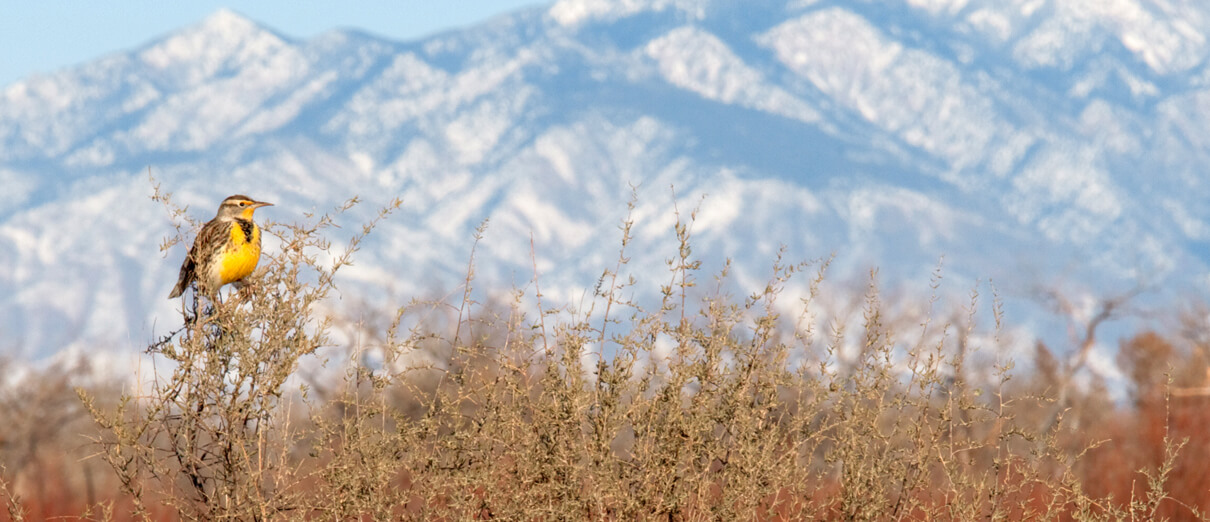
The Western Meadowlark's diet varies with the seasons, consisting mostly of grains in winter and early spring, insects throughout the breeding season, and weed seeds in the fall.
Like its eastern counterpart, this species forages for its food on the ground, using its long, strong beak to reach into grass tussocks and to probe underground for insects and seeds. While probing, the meadowlark inserts its closed bill into the ground or a grass clump, then pries open its mandibles to access its food. This behavior, known as gaping, is seen in other members of the blackbird family (Icteridae), including the Common Grackle. European Starlings also gape when feeding on the ground, especially on lawns.
Region and Range

Western Meadowlark populations are resident in the western and south-central parts of their range, while northern U.S. and Canadian populations migrate to winter as far south as the dry grasslands of northern Mexico, where they join other wintering birds such as the Thick-billed Longspur, Horned Lark, and Long-billed Curlew.
In the central United States, the Western Meadowlark's range broadly overlaps that of the Eastern Meadowlark, although the two species rarely hybridize. In some parts of the Southwest, the Western Meadowlark overlaps range with the newly named Chihuahuan Meadowlark, which had formerly been considered an isolated Eastern Meadowlark population.
Conservation
Although the Western Meadowlark remains common in many places, it's still a species in trouble. Over the last 50 years, its population has fallen by more than 40 percent due to habitat loss, pesticide use, and human activities such as haying, which, if done during peak nesting season, can wipe out grassland bird broods. As habitat on both breeding and wintering grounds disappears, grassland species have become one of the fastest-declining suites of birds in North America.

Help support ABC's conservation mission!
ABC is working to conserve and restore critical grassland habitats that the Western Meadowlark needs to survive. Our BirdScapes program works to conserve habitats that migratory birds require during different times of year. We also continue advocating for the cancellation of dangerous pesticides that threaten insect-eating birds.
Get Involved
Policies enacted by the U.S. Congress and federal agencies, such as the U.S. Fish and Wildlife Service, have a huge impact on America's birds. You can help shape these rules for the better by urging lawmakers to prioritize birds, bird habitat, and bird-friendly measures. To get started, visit ABC's Action Center.
Living a bird-friendly life can have an immediate impact on the birds around you. Doing so can be as easy as adding native plants to your garden, avoiding pesticides, and keeping cats indoors. To learn more, visit our Bird-Friendly Life page.
American Bird Conservancy and our Migratory Bird Joint Venture partners have improved conservation management on more than 6.4 million acres of U.S. bird habitat — an area larger than the state of Maryland — over the last ten years. This is a monumental undertaking, requiring the support of many, and you can help by making a gift today





































